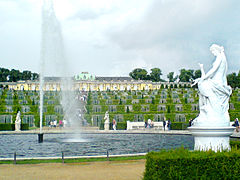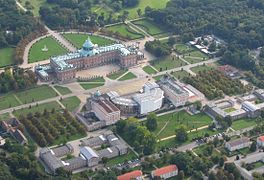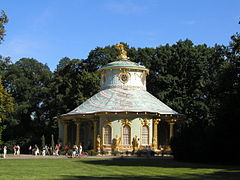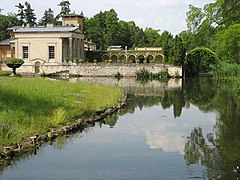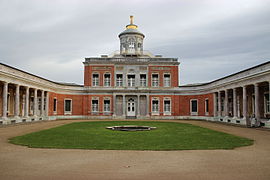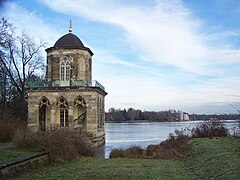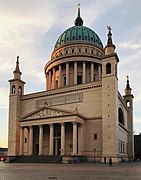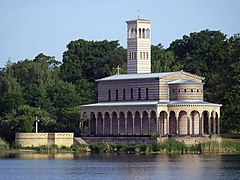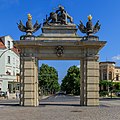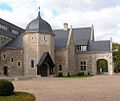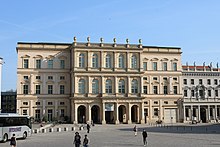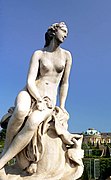List of sights in Potsdam
The following list contains sights of the Brandenburg state capital Potsdam .
Sanssouci Park
The historic Sanssouci park covers an area of around 290 hectares, making it the largest and most famous in the Mark Brandenburg. In the 18th and 19th centuries, Frederick the Great and Frederick William IV shaped the complex in the contemporary styles of Rococo and Classicism and had a total work of art built from architecture and garden design, the heart of which are the vineyard terraces with the crowning Sanssouci Palace.
- Sanssouci Palace (built between 1745 and 1747, symbol of the city)
- Neues Palais (1763 to 1769)
- Charlottenhof Palace (1826 to 1829)
- Orangery Palace , also Orangerie or New Orangery called (1851-1864)
- New chambers (1771 to 1775)
- Picture gallery (1755 to 1764)
- Chinese tea house (1755 to 1764)
- Friedenskirche (1845 to 1848)
- Temple of Antiquities (1768/1769)
- Friendship stamp (1768 to 1770)
- Roman baths (1829 to 1840)
- Belvedere on the Klausberg (1770 to 1772)
- Drachenhaus on the Klausberg (1770 to 1772)
- Historic mill of Sanssouci (1736 to 1739, first reconstruction from 1790, 1945 destruction through combat operations, reconstruction 1983 and 1990 to 1993)
- Neptune's grotto (from 1751)
- Green bars at the park entrance
- Potsdam Botanical Garden
- No longer to visit: the fort in the park of Sanssouci (1893). Model fort near the New Palace. Filled in since 2004.
- Pheasantry
New garden
The New Garden is a park area of around 100 hectares that borders the Heiligen See and the Jungfernsee in the north of Potsdam . Friedrich Wilhelm II had a new garden laid out on this area from 1787, hence the name. According to the contemporary taste of the English garden, the park should deliberately stand out from the outdated forms of the Baroque ornamental and kitchen garden Sanssouci.
- New garden (facility from 1787)
- Marble Palace (1787 to 1792)
- Castle kitchen, in the form of a temple ruin (1788 to 1790)
- Orangery (1791 to 1793)
- Gothic library (1792 to 1794)
- Pyramid (1791 to 1792)
- Dairy farm (1790 to 1792)
- Crystal and shell grotto (1791/92)
- "Holländisches Etablissement" (Dutch-style houses)
- Garden houses: white, brown, red and green house
- Cecilienhof Palace (1914 to 1917)
Babelsberg Park
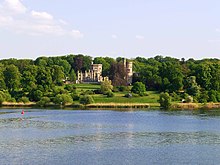
Adjacent to the Tiefen See of the Havel is the 114 hectare park Babelsberg. On behalf of Prince Wilhelm, later Emperor Wilhelm I and his wife Augusta , the garden artists Peter Joseph Lenné and Prince Hermann von Pückler-Muskau designed the hilly terrain sloping down to the lake into a park landscape from 1833 .
- Park Babelsberg (facility from 1833)
- Marstall (1834 to 1839 and 1861)
- Babelsberg Palace (1835 to 1849)
- Small castle (1841/42)
- Sailor's House (1842)
- Steam engine house (1843 to 1845)
- Flatow Tower (1853 to 1856)
- Court arbor (1871)
Gardens
- Friendship Island in the city center with the Karl Foerster perennial garden.
- Karl Foerster Garden in Potsdam-Bornim with his private house.
- Lustgarten as the oldest garden in Potsdam, originally part of the city palace complex.
- Volkspark Potsdam on the former federal horticultural show site 2001 with the Biosphere Potsdam , a commercially operated park.
- Wildlife Park (1834 to 1838), one of the oldest examples of the connection between courtly tradition and landscape gardening. The wildlife park is over 875 hectares and is located west of the Sanssouci Park.
- Bornstedter Friedhof, over 400 years old park with an Italian-style church. Ferdinand von Arnim , Peter Joseph Lenné and Ludwig Persius , among others, are buried .
Castles
- For an overview of all castles see Castles in Potsdam
Churches
The Prussian tolerance that cannot be overlooked in the city is also expressed in Potsdam's churches: in the middle of Protestant Potsdam there is a large Catholic church, and the oldest Russian Orthodox church in Germany is also located here. Houses of worship were built for colonists from all over Europe: Swiss, French, Bohemians ...
- For an overview of all churches see the list of churches in Potsdam
City gates
As a garrison town, Potsdam had a city wall with ten city gates . With their elaborate architectural styles, these served more for representation than for defense. Only four of the city gates are fully visible in the cityscape, two more only in fragments.
- Brandenburg Gate (1770)
- Nauener Tor : Building plans by Johann Gottfried Büring after 1754 made sketches by King Friedrich II. First example of neo-Gothic on the European continent.
- Hunter's Gate (1733)
- Cellar gate : the Potsdam water gate at the inflow of the city canal. Erected in 1788, rebuilt in 2017
Cellar gate on the city canal
Districts and ensembles
District
- Dutch Quarter (1733-1740)
- Alexandrowka (Potsdam) (1826/1827) with the Alexander Nevsky Memorial Church (laying of the foundation stone in 1826, consecration in 1829)
- Potsdam-Babelsberg (around 1900) and the villa colony Neubabelsberg as well as the Bohemian weavers' quarter
- Brandenburger Strasse with the adjoining city center (Potsdam's shopping street in the city center as a pedestrian zone, delimited by the St. Peter and Paul Church and the Brandenburg Gate.)
- Berlin suburb (from the 2nd half of the 19th century)
- Potsdam West
- Teltower suburb
Facilities and places
-
Old market , historical center of the city.
- Potsdam City Palace , (1662 to 1669, 1744 to 1752; was damaged in 1945, a reconstruction as the seat of the Brandenburg State Parliament was completed with the opening on January 21, 2014)
- Fortunaportal , (1701 to 1740) reconstruction 2001/02.
- Old town hall , built in baroque style in 1753 according to an unexecuted design by Andrea Palladio for the Palazzo Angarano in Vicenza .
- New market , baroque square almost completely preserved.
- Luisenplatz , (from 1733), baroque square between Brandenburger Straße and the entrance to Sanssouci Park.
- Bassinplatz with the St. Peter and Paul Church and the French Church.
- Unity Square , centrally located square with modern and historical architecture.
- Glienicke Bridge , (late 17th century), known for the exchange of agents during the Cold War.
- Airship port Potsdam
- Film studio Babelsberg and Filmpark Babelsberg
- Kulturviertel Schiffbauergasse with the Hans Otto Theater , the Schinkelhalle and the wash house .
Old town hall on the old market
building
- Former Great Military Orphanage
- Hiller-Brandtsche houses
- Jan Bouman's house in the Dutch Quarter
- Karstadt department store with Art Nouveau facade and atrium
- Werner-Alfred-Bad
- Steam engine house with pumping station for Park Sanssouci in the shape of a mosque on Neustädter Havel Bay
- Kaiserbahnhof (1905 to 1909) The Kaiserbahnhof (originally courtyard station in Wildpark) was reopened on June 16, 2005 after a restoration . Since then, the building has been used as an academy for managers at Deutsche Bahn.
- Bavarian house
- Einstein Tower (1920 to 1921) on the Telegrafenberg
- former war school
-
Belvedere on the Pfingstberg (1847 to 1852, 1860 to 1863)
- Temple of Pomona (around 1800) , the first work by Karl Friedrich Schinkel
- Glass candy factory the company Katjes , visitors can watch the candy production by a gallery of the entire process.
Former Great Military Orphanage
Museums and exhibitions
- Barberini Museum
- Potsdam Museum
- House of Brandenburg-Prussian History on the Neuer Markt
- museum FLUXUS +
- Urania Planetarium in the Dutch Quarter
- Natural History Museum Potsdam
- Exploratorium Potsdam
- KGB prison Potsdam
- Jan Bouman's house
- Nikolaisaal
- Alexandrowka Museum
- "Mozart House", Am Bassin 10
- Einsteinhaus Caputh
- Filmmuseum Potsdam in the historic Marstall, the oldest preserved building in the city
- Nowaweser Weberstube in the Bohemian weavers' quarter
-
Kita-Museum about education in the two German states (from its founding in 1997 to 2000);
next stopovers in Groß Glienicke , Nennhausen and Falkensee ; in 2018 the relocation to Lüneburg takes place - S-Bahn Museum at Griebnitzsee station
Villas
Since the 1990s, many architecturally interesting villas have been restored:
- Villa colony Neubabelsberg
- Villa Ingenheim
- Villa Liegnitz
- Villa of Diringshofen
- Villa Kampffmeyer at the Glienicke Bridge
- Villa Schöningen at the Glienicke Bridge
- Villa Heydert
- Villa Rohn or Löwenwilla, named after the lions in front of the facade. Since 1941 in the possession of the family von Fritz von der Lancken, a resistance fighter of the Third Reich.
- Herbertshof, named after Herbert Gutmann, with the Arabic room
- Palace of Countess Lichtenau , on the Holy See
- Villa Bach, Spitzweggasse
- Villa Ernst von Bergmann, Berliner Strasse
- Villa Gericke , Puschkinallee 17
- Villa Gutmann
- Villa Kellermann
- Villa Kutscherhaus, Persiusstr.
- Villa General Ladental
- Villa Mendelssohn, named after the Jewish factory owner Otto von Mendelssohn Bartholdy
- Villa Mosler
- Villa hull
- Villa Sarre with lion frieze
- Villa Spillner; protected as an existing building, Böcklinstrasse / Tizianstrasse
- Villa Starke (Potsdam-Babelsberg)
- Villa Stülpnagel , Am Neuen Garten 35, with a splendid coffered door; in the fireplace room there is a large historical map of Berlin in Russian script.
- Villa Wiener, K. Adenauer lived here in 1934
- Villa Lademann, where Heinz Rühmann lived during the shooting, the house was built by Otto Lilienthal's brother, Gustav Lilienthal
- Villa Alfred Zeisler, by Marika Röckk
Visual arts
The city of Potsdam has a variety of fine arts in the form of sculptures and paintings. The paintings are mainly distributed among the buildings in Sanssouci Park, the Potsdam Museum and the city's churches. The sculptures are mainly distributed in the parks, especially in Sanssouci Park. A lapidarium exhibits some of the originals of the statues.
-
Paintings (selection)
- Caravaggio - The Incredible Thomas ( Image Gallery )
- Guido Reni - Death of Cleopatra (Image Gallery)
- Peter Paul Rubens - Saint Jerome (Image Gallery)
- Antoine Watteau - The Dance ( Neues Palais )
- Anthonis van Dyck - The outpouring of the Holy Spirit
- Antoine Pesne - The Agony of Christ ( St. Peter and Paul Church )
-
Sculptures (selection)
- Monument to the Unknown Deserter on Unity Square
- Lapidarium in the Small Orangery ( New Chambers ) in Sanssouci Park
- Sanssouci Park , especially the New Palace with 400 statues or the Mohrenrondell
- Friendship Island
- The Grün family
Venus by Jean-Baptiste Pigalle in Sanssouci Park
The incredulous Thomas von Caravaggio in the picture gallery
The dance of Antoine Watteau
Waters
- Havel and Potsdamer Havel with
- Sacrow-Paretz Canal with
- Teltow Canal with
- Holy lake
- City canal , has been reconstructed since 1999
The Green House in the New Garden on the Holy See
Former buildings
- Potsdam City Palace , damaged in World War II, later blown up and finally reconstructed as the Brandenburg State Parliament building.
- Garrison church , damaged in World War II, later blown up. Reconstruction of the tower began in 2017.
- The Royal Theater , Am Kanal 8 (popularly "Canal Opera"). The building was destroyed by artillery fire on April 25, 1945. The façade still preserved was demolished in 1966.
- Eight corners , only one of four baroque corner houses has been preserved.
- The Gloriette on Bassinplatz , demolished after the Second World War and replaced by a Soviet cemetery.
- Large parts of the French Quarter have been preserved as the French Church .
- Berliner Tor, only one side wing is preserved.
- Neustädter Tor, only a single obelisk is preserved.
- The long stable , burned down in 1945, only the elaborate front facade was preserved.
- The city canal with its numerous bridges was filled in by 1965, it is to be completely reconstructed.
- Heilig-Geist-Kirche , 1945 badly damaged, 1960 demolition of the nave ruins, 1974 demolition of the tower stump. In 1997 a new building was built in the outline of the church as a senior citizens' residence.
- Bethlehem Church on Neuendorfer Anger, badly destroyed in 1945, blown up in 1952.
- Synagogue, looted in 1938, destroyed in 1945.
- The palace hotel on the Havel and large parts of the Breite Straße.
Long stable front facade
literature
- Andreas Kitschke: The Potsdam churches . Kunstverlag Peda, Passau 2001, ISBN 3-89643-530-2 .
- Potsdam palaces in history and art . 4th edition. VEB FA Brockhaus Verlag, Leipzig 1984, ISBN 3-325-00030-4 (Ed .: State Archive Administration of the GDR, State Palaces and Gardens Potsdam-Sanssouci).
Web links
Individual evidence
- ↑ Marlies Schnaibel: Kita Museum leaves Falkensee . In: Märkische Allgemeine Zeitung , insert Havelland , April 10, 2018, p. 13.

